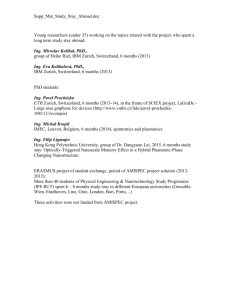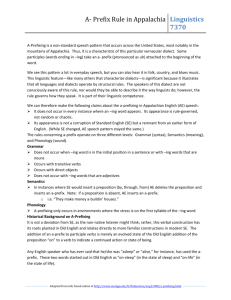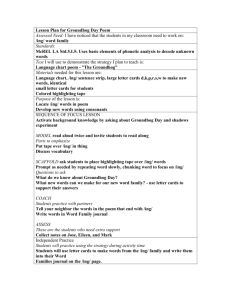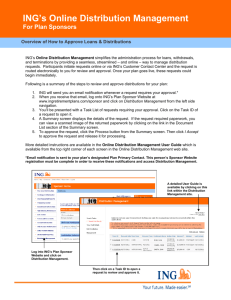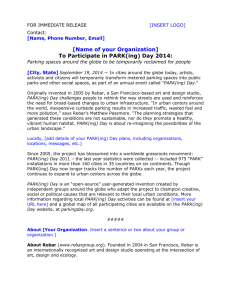ING Insurance Economic Capital Framework
advertisement
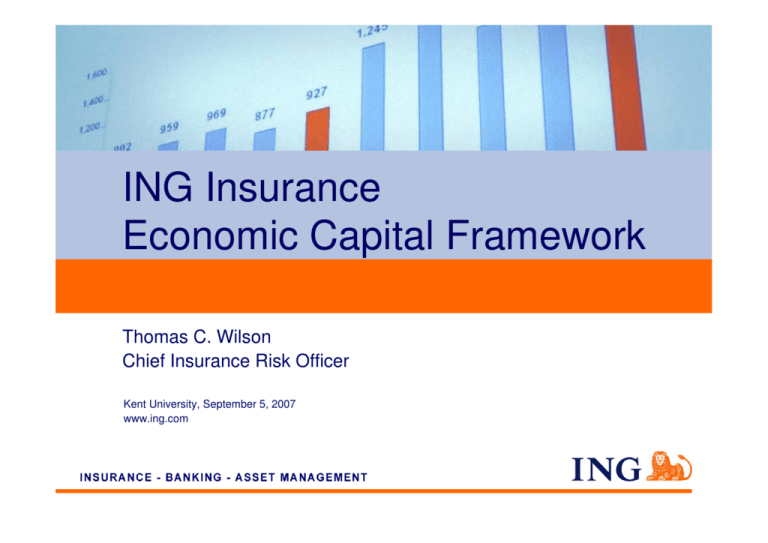
ING Insurance Economic Capital Framework Thomas C. Wilson Chief Insurance Risk Officer Kent University, September 5, 2007 www.ing.com Objectives of this session • ING has been using economic capital internally over many years to support management decisions within an Enterprise Risk Management framework • The framework which ING has developed is unique in many respects, being based on • An economic or market value balance sheet • Using replicating portfolios in order to model the financial component of liabilities • In this session, we would like to accomplish two important objectives: • First, demonstrate how economic capital integrally supports risk and value management within ING • Second, describe our economic capital framework and provide some insights Insurance - Banking - Asset Management 2 Contents • Role of economic capital at ING Insurance • ING’s economic capital framework • ING’s risk profile Insurance - Banking - Asset Management 3 How concretely does Insurance Risk Management support ING strategy? IRM Mission Statement: Together with the business, build a sustainable competitive advantage by fully integrating risk management in our daily business activities and strategy and ensure that: Risk Disclosure Our risks and strategy are transparent to internal and external stakeholders to support an appropriate evaluation Risk Strategy Delegated authorities are consistent with the overall Group strategy for profitable growth and the Group’s risk appetite Risk Controlling Risk Underwriting Our risk profile is transparent, e.g. “no surprises”, and consistent with delegated authorities Our products and portfolios are structured, underwritten, priced, approved and managed appropriately Insurance - Banking - Asset Management 4 How does Economic Capital support Insurance Risk Management’s mandate? Examples Risk Disclosure Risk Strategy Risk Controlling Risk Underwriting Role of Economic Capital • Risk disclosures • Embedded value reporting • Investor disclosures • IFRS 7 Risk Paragraph • Basis for Solvency II • Risk appetite / “hotspots” • Strategic planning & targets • Defines economic solvency • Calibrates capital for traditional value metrics • Basis for market value metrics • Economic capital & limits • Value metrics, e.g. vROEC • Capital management & planning • Risk Dashboard • Limits • Core element of risk measurement and limit framework • Standards of Practice/Guidelines • Incorporated in PARP • Value metrics / targets – IRR, • Calibrates traditional value market consistent metrics • Product Approval Process (PARP) • Basis for market value metrics Insurance - Banking - Asset Management 5 What is Insurance Risk Management? Group CRO Koos Timmermans Audit & Risk Committee Group CIRO Thomas C. Wilson Finance & Risk Committee CIRO Canada CIRO Rest of Europe CIRO US CIRO Division Intermediaries CIRO Asia Pacific Asset/Liability Committees • Group • Regional • Local Model Parameter Committee CIRO Latin America • Global network of 725+ combined risk / actuarial professionals in 30+ countries • Internationally recognized: • One of only three insurers globally with S&P Excellent ERM rating • 2006 Insurer of the Year, Risk Magazine • 2007 Insurance CRO of the Year, Life & Pensions Magazine Insurance - Banking - Asset Management 6 Contents • Role of economic capital at ING Insurance • ING’s economic capital framework • ING’s risk profile Insurance - Banking - Asset Management 7 Overview of ING Economic Capital Framework Definition: ING Insurance economic capital defined as maximum loss to ING Insurance’s Market Value Surplus (MVS) within a 99.95% confidence interval based on shocks which could occur over a one year horizon Market Value Assets One year MVS Scenarios Market Value Liabilities Expected value EC MVS Based on total Market Value Surplus • Current balance sheet value, no future business • Market Value of Liabilities, including options and guarantees, not best estimate liabilities • Includes free surplus; no assumption about “duration of equity” or surplus Insurance - Banking - Asset Management 99.95% worst case 99.95% confidence interval • Consistent with AA rating • More conservative than minimum Solvency II Consistency with Solvency II • Maximum loss / “VaR” not tail risk • One year horizon, not run-off 8 Market Value of Liabilities • Definition: The market value of each of ING’s insurance liabilities is defined as the current cash value which would be required by an independent, professional, well diversified and financially secure insurance company or investor in order for them to assume the liability in an orderly manner. • Comments • Exit or transfer value • Each individual liability (and asset) is valued on a stand alone basis • Liabilities divided into two components: Financial Component of Liabilities (FCL) and Market Value Margin (MVM) Liabilities Which Do Not Depend on Financial Markets, eg Term Life, Non-Life Liabilities Which-Do Depend on Financial Markets, eg SPVA, etc Value of options/guarantees/ profit sharing Liability cashflow Liability cashflow + = Fixed Fixed payouts payouts Financial component Insurance - Banking - Asset Management Non - financial component = Guaran Guaran teed teed liabilities liabilities Financial 9 + Non - financial component (MVM) Risks which impact Market Value Surplus Financial risk Credit & transfer Insurance risk risk Operational risk Business risk Changes in financial markets which would impact the market value of assets and liabilities (including options in assets and liabilities) from: Changes in the credit quality of assets, reinsurance receivables and counterparties, including default. Unexpected events such as processing errors, fraud, systems failures, litigation, regulatory or compliance breaches, etc. Deviations from best estimates on business expenses, lapses / persistency and future premium re-rating • • • • • • Interest rates Equity prices Real estate Credit spreads Implied vols Currency rates The recovery risk in case of default or loss of value due to migration. The inability to repatriate or transfer shareholder value due to transfer restrictions. Insurance - Banking - Asset Management Deviations from best estimate claims development, including size, frequency and timing of both level and long term trend, covering: • • • • • • Mortality Morbidity Longevity risk Property Casualty NATCAT 10 Best Practice Models Within and Across Risks Across risk classes • Best-in-class aggregation model • Conservative correlation assumptions Risk Aggregation (“Gaussian Copula” based on conservative correlations) Financial risk Credit & transfer risk Insurance risk Operational risk Monte Carlo simulation MKMV portfolio manager, meeting BIS II advanced Actuarial models for each risk, inhouse and external Internal/ Internal models external data / model, meeting BIS II advanced Historical vol & correlations, 5 yr weekly data MKMV correlations Management correlation assumptions Management correlation assumptions Insurance - Banking - Asset Management 11 Business risk Management correlation assumptions For each risk • Best-in-class models • Best estimate correlations Summary of Challenges of current EC process Source Data Cash flow Systems Actuarial Analysis System Spreadsheets Regional Office Spreadsheets BU 1 BU 2 Consolidated Reporting Spreadsheets CIRM Current Data Interface = EC / Shocks • Efficiency: Complex processes & system environment implying need to automate interfaces, optimize hardware / software, balance precision & effort, leverage development • Control & Audit: Confidence in numbers & consistency, implying need for clear standards, improved systems, documentation, controls & procedures • Functionality: Improved methods and greater analysis needs, implying need for changing data interface and new techniques • In 40+ different units + 8 Regional Offices + CIRM globally! Insurance - Banking - Asset Management 12 Overview of ECAPS Project Approach Source Data Cash flow Systems Actuarial Analysis System Spreadsheets Consolidated Reporting Spreadsheets BU 1 Improved interface, pushing boundary ECAPS Tool Web-Based Access to Input Improved analysis at BU, Region, and CIRM And Results at BU • Available on the desktop of BU CIROs and risk professionals • Significantly reducing the number of downstream spreadsheets • Improved Analytics: based on industry market risk platform well known within ING (e.g. Algorithmics) • Facilitating timely reporting Insurance - Banking - Asset Management 13 Improved methods Replicating portfolio approach – insurance contract as bundle of financial products Insurance contract financial component Standard capital market equivalents • Best estimate claims, expenses, etc. • Zero coupon cash flows • Minimum accumulation guarantees, ratchets, etc. • Put option on underlying asset returns, ratchet options, etc. • Option to annuitize at predetermined rate • Interest rate swaption • Crediting rate influenced by current long term investment conditions • Constant maturity swap pay-out • Increased lapses driven by increasing rates, persistency driven by decreasing rates • American style put option on underlying insurance contract ING Replicating Portfolio Approach What portfolio of standardized capital market instruments best represents the cash flow uncertainty of the insurance contract under a wide range of economic scenarios? Assessment criteria: R-Squared (goodness of fit measure), sensitivities (“Greeks”, duration, convexity, tail behavior, etc.) • Accurate representation of value and risk profile • Supports optimal hedge decisions • Reinforce financial engineering during product design and pricing Insurance - Banking - Asset Management 14 ECAPS Overview ECAPS Tool Via Intranet Scenario Generator Economic Capital (EC) Calculation Replicating Portfolio (X/Y) Reporting Business Unit (BU) • Focus on providing asset/ liability data and non-market risk EC Insurance - Banking - Asset Management 15 Where do these scenarios come from? • Automated process via ING’s Global Market Database • Scenarios generated quarterly for EC calculations • Market data from real data as much as possible • Incomplete Market data and Non-market data linked to known market data as much as possible • Few remaining items based on expert judgment Get Market Data Bloomberg Reuters Develop Correlations/ Volatilities ALGO Scenario Generator ING’s ECAPS GMDB Lehman Bros CIRM Insurance - Banking - Asset Management 16 ING replicating portfolio approach – Comparing target with replicating portfolio Insurance - Banking - Asset Management 17 ING replicating portfolio approach – Understanding portfolio characteristics Insurance - Banking - Asset Management 18 Additional information useful for interpreting the numbers • Corporate line is defined by a set of internal transactions representing • Group funding transactions and associated hedges • Virtual transfer of free surplus from US, NN, and Taiwan • This is not fully consistent with the corporate line presented for P/L • Recognition of risk diversification • ING EC model assumes full ability to move capital if necessary to cover a loss in a specific legal entity • Diversification benefits across businesses are fully allocated to business units on a proportional basis relative to undiversified EC • Economic capital is based on instantaneous quarterly shocks, scaled to annual value impact with recognition given for explicitly recognized dynamic hedging programs Insurance - Banking - Asset Management 19 Contents • Role of economic capital at ING Insurance • ING’s economic capital framework • ING’s risk profile Insurance - Banking - Asset Management 20 ING Insurance Economic Capital Profile 12.06 Risk breakdown Geographic Breakdown 4% 4% 25% 15% 14% 14% 62% 6% 32% Americas Corp Line 24% Europe Not Modelled Asia Pacific Financial Non-financial ING Economic Capital • Balanced across regions • Dominated by financial risks Insurance - Banking - Asset Management 21 Credit Not Modelled Insurance ING Insurance solvency position As of 12.06 Economic Solvency Statutory Solvency Euro billion Euro billion Insurance - Banking - Asset Management Economic Capital Available Financial Resources Deferred Tax Liability Market Value Adjustments Tier 1 Sub Debt Shareholders equity 0 22 0 Book Equity EU Solvency (100%, 150%) ING Insurance benefits from geographic and risk diversification Euro billions, 12.31.06 Geographic Risk 36% 31% 0 0 Undiversified EC Financial risk Insurance risk Diversified EC Undiversified EC Diversified EC Credit risk Non-financial risk Americas Asia Pacific Diversified EC Europe Corporate Line Diversified EC ING enjoys strong benefits from diversification with total diversification = XX% • Diversification across risk categories = 31% • Diversification across regions = 36% Insurance - Banking - Asset Management 23 Certain of the statements contained herein are statements of future expectations and other forward-looking statements. These expectations are based on management's current views and assumptions and involve known and unknown risks and uncertainties. Actual results, performance or events may differ materially from those in such statements due to, among other things, (i) general economic conditions, in particular economic conditions in ING’s core markets, (ii) performance of financial markets, including emerging markets, (iii) the frequency and severity of insured loss events, (iv) mortality and morbidity levels and trends, (v) persistency levels, (vi) interest rate levels, (vii) currency exchange rates (viii) general competitive factors, (ix) changes in laws and regulations, (x) changes in the policies of governments and/or regulatory authorities. ING assumes no obligation to update any forward-looking information contained in this document. www.ing.com Insurance - Banking - Asset Management 24

